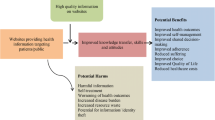Abstract
Objective
The aim of this study was to assess the quality of patient information on bariatric surgery in the internet using the modified Ensuring Quality Information for Patients (EQIP) tool.
Methods
Systematic review of information on bariatric surgery in the internet by entering common search terms into five search engines. The top 100 websites of every search term and search engine were assessed using the validated EQIP tool (maximum score, 36), which entails points for content, structure, and identification data of a given website. Websites at or above the 99th percentile were analyzed separately (n = 8).
Results
The median EQIP score of all included websites (n = 463) was 17 (IQR 15–19). While information on the medical problem, the indication for surgery, or the treatment alternatives was present in 84% of all websites, only 10% of the included websites contained adequate information on postoperative complications. Although quantitative information on incidence (37.5%) and treatment of complications (12.5%) was significantly better in the top 99th percentile websites, the content of relevant information such as occurrence and treatment of complications was still very limited.
Conclusion
The overall quality of patient information on bariatric surgery in the internet is relatively poor. Especially incidence of complications and their treatment are rarely reported even on websites with a 99th percentile EQIP score.



Similar content being viewed by others
References
Eurostat. Availa ble from: http://ec.europa.eu/eurostat/en/data/database; http://www.webcitation.org/6r2zJ4bD4.
Madan AK, Frantzides CT, Pesce CE. The quality of information about laparoscopic bariatric surgery on the Internet. Surg Endosc. 2003;17(5):685–7.
Eysenbach Gunther SER, Diepgen Thomas L. Shopping around the internet today and tomorrow: towards the millennium of cybermedicine. BMJ. 1999;319:1294.
Hesse BW, Nelson DE, Kreps GL, et al. Trust and sources of health information: the impact of the Internet and its implications for health care providers: findings from the first Health Information National Trends Survey. Arch Intern Med. 2005;165(22):2618–24.
Sonnenberg FA. Health information on the Internet. Opportunities and pitfalls. Arch Intern Med. 1997;157(2):151–2.
Booth A. Netting the evidence: finding pearls, not sewage. Singapore Med J. 2006;47(12):1023–9.
Gowers SG, Shore A. The stigma of eating disorders. Int J Clin Pract. 1999;53(5):386–8.
O’Brien PE, Dixon JB. The extent of the problem of obesity. Am J Surg. 2002;184(6B):4S–8S.
Wilson FL. Are patient information materials too difficult to read? Home Healthc Nurse. 2000;18(2):107–15.
Gibson PA, Ruby C, Craig MDA. Health/patient education database for family practice. Bull Med Libr Assoc. 1991;79(4):357–69.
Charnock D, Shepperd S, Needham G, et al. An instrument for judging the quality of written consumer health information on treatment choices. J Epidemiol Community Health. 1999;53(2):105–11.
Shepperd S, Charnock D, Cook A. A 5-star system for rating the quality of information based on DISCERN. Health Info Libr J. 2002;19(4):201–5.
Silberg WM, Lundberg GD, Musacchio RA. Assessing, controlling, and assuring the quality of medical information on the Internet: Caveant lector et viewor—Let the reader and viewer beware. JAMA. 1997;277(15):1244–5.
Moult B, Franck LS, Brady H. Ensuring quality information for patients: development and preliminary validation of a new instrument to improve the quality of written health care information. Health Expect. 2004;7(2):165–75.
Charvet-Berard AI, Chopard P, Perneger TV. Measuring quality of patient information documents with an expanded EQIP scale. Patient Educ Couns. 2008;70(3):407–11.
Frueh FS, Palma AF, Raptis DA, et al. Carpal tunnel syndrome: analysis of online patient information with the EQIP tool. Chir Main. 2015;34(3):113–21.
Melloul E, Raptis DA, Oberkofler CE, et al. Donor information for living donor liver transplantation: where can comprehensive information be found? Liver Transpl. 2012;18(8):892–900.
Palma AF, Zuk G, Raptis DA, et al. Quality of information for women seeking breast augmentation in the Internet. J Plast Surg Hand Surg. 2016;50(5):262–71.
Ademiluyi G, Rees CE, Sheard CE. Evaluating the reliability and validity of three tools to assess the quality of health information on the Internet. Patient Educ Couns. 2003;50(2):151–5.
[20.03.2017]; Available from: http://rbiostatistics.com/node/1; http://www.webcitation.org/6r2xrt2QJ.
Makar B, Quilliot D, Zarnegar R, et al. What is the quality of information about bariatric surgery on the internet? Obes Surg. 2008;18(11):1455–9.
Angrisani L, Santonicola A, Iovino P, et al. Erratum to: bariatric surgery and Endoluminal procedures: IFSO worldwide survey 2014. Obes Surg. 2017;27(9):2290–2.
Corcelles R, Daigle CR, Talamas HR, et al. Assessment of the quality of internet information on sleeve gastrectomy. Surg Obes Relat Dis. 2015;11(3):539–44.
Boyer C, Baujard V, Geissbuhler A. Evolution of health web certification through the HONcode experience. Stud Health Technol Inform. 2011;169:53–7.
Acknowledgments
We would like to thank Friederike Körsgen for contributing to the data-collection.
Author information
Authors and Affiliations
Corresponding author
Ethics declarations
Conflicts of Interest
The authors declare that they have no conflict of interest.
Ethical Approval
This article does not contain any studies with human participants or animals performed by any of the authors.
Electronic supplementary material
Supplementary Table 1
(TIFF 26330 kb)
Supplementary Figure 1
(DOCX 79 kb)
Rights and permissions
About this article
Cite this article
Vetter, D., Ruhwinkel, H., Raptis, D.A. et al. Quality Assessment of Information on Bariatric Surgery Websites. OBES SURG 28, 1240–1247 (2018). https://doi.org/10.1007/s11695-017-2983-0
Published:
Issue Date:
DOI: https://doi.org/10.1007/s11695-017-2983-0




